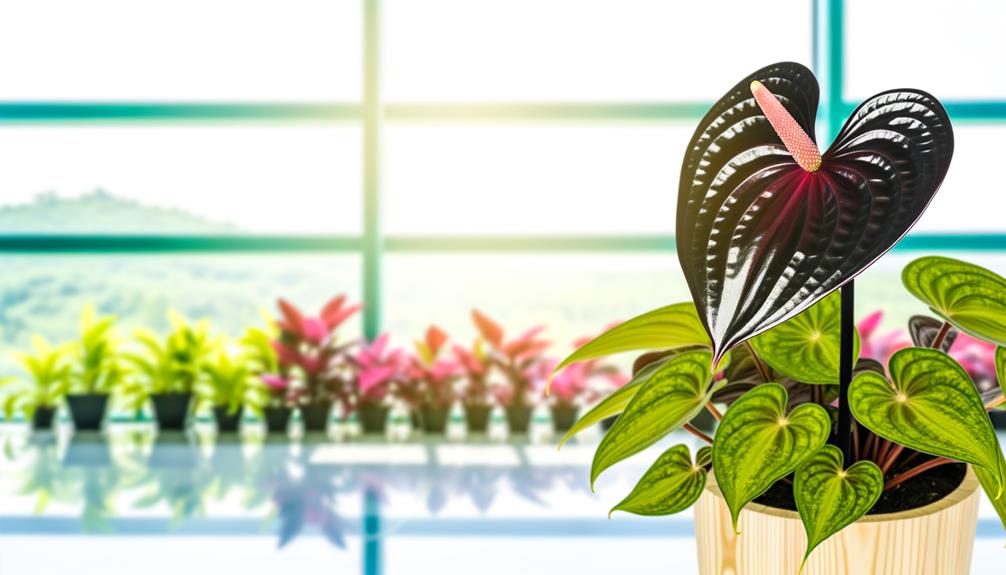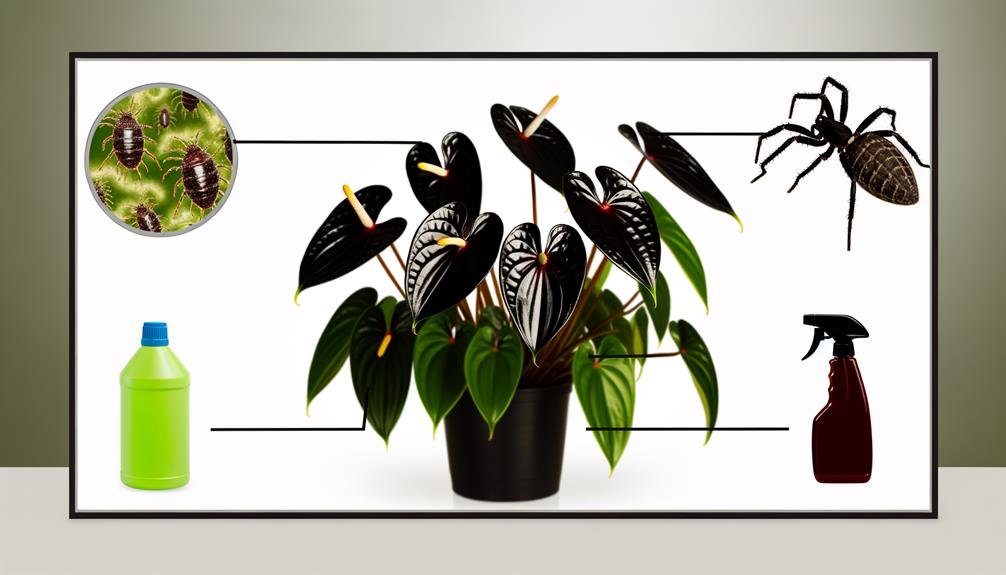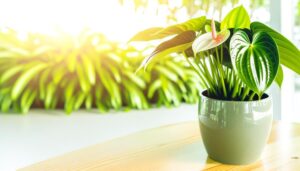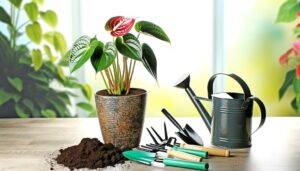5 Essential Steps for Black Anthurium Care
For your Black Anthurium, choose a location with bright, indirect light to avoid leaf damage, and maintain temperatures between 65-80°F. Water thoroughly with lukewarm, filtered water when the top 1-2 inches of soil are dry.
Use a half-strength, 20-20-20 water-soluble fertilizer and apply it directly to the soil. Keep humidity levels at 60-80%, using a humidifier or misting regularly.
Inspect for pests often and treat with insecticidal soap or neem oil, and trim any diseased foliage to prevent spread. By following these steps, you’ll guarantee your Black Anthurium thrives and grows vibrantly.
Discover more to perfect your care routine.

Key Takeaways
- Place Black Anthurium in indirect, bright light, avoiding direct sunlight.
- Water thoroughly with lukewarm, filtered water when the top 1-2 inches of soil are dry.
- Use diluted, water-soluble fertilizer with a 20-20-20 N-P-K ratio for regular feeding.
- Maintain humidity levels between 60-80% using a humidifier or humidity tray.
- Inspect regularly for pests and treat with insecticidal soap or neem oil as needed.
Choosing the Right Location

When selecting the right spot for your Black Anthurium, it should receive indirect, bright light to support optimal growth and vibrant blooms. Avoid placing it in direct sunlight, as this can scorch the leaves and harm the plant.
A north or east-facing window works well, providing ample light without the harshness. If natural light is insufficient, consider using grow lights that replicate sunlight.
Ensure the room temperature remains between 65-80°F (18-27°C) and avoid cold drafts or sudden temperature changes.
High humidity levels, ideally between 60-80%, are essential. You can increase humidity by placing a humidifier nearby or setting the pot on a tray filled with water and pebbles.
Proper placement is key to flourishing, beautiful Black Anthuriums.
Watering Techniques
Proper watering is essential for maintaining the health and vibrancy of your Black Anthurium. Guarantee you water thoroughly, allowing excess to drain out, preventing root rot.
Use lukewarm, filtered water to avoid shocking the plant with temperature or chemicals. Water the plant when the top 1-2 inches of soil feel dry to the touch. Consistency is key, so establish a regular schedule, adjusting for seasonal changes.
Mist the leaves occasionally to mimic a humid environment, but avoid waterlogging the soil. Checking the drainage holes ensures they’re not clogged, promoting healthy airflow.
Proper Fertilization

Fertilizing your Black Anthurium with a balanced, water-soluble fertilizer every 6-8 weeks during the growing season will ensure it receives the essential nutrients needed for peak growth and vibrant blooms. Choose a fertilizer with an N-P-K ratio of 20-20-20 for best results.
Dilute the fertilizer to half-strength to avoid over-fertilizing, which can damage the plant’s roots. Apply the solution directly to the soil, ensuring even distribution without wetting the leaves.
Monitor your plant’s response; yellowing leaves may indicate nutrient deficiency, while browning tips might signal excessive fertilization. Adjust the frequency or concentration accordingly.
Consistent fertilization will help your Black Anthurium thrive, providing the necessary support for healthy foliage and stunning flowers, enhancing its overall visual appeal.
Ideal Humidity Levels
To maintain your Black Anthurium thrives, keep humidity levels between 60% and 80% by using a humidifier or placing the plant on a humidity tray.
High humidity is essential for this tropical beauty, ensuring its leaves remain lush and glossy. Regularly misting the plant can also help, but avoid over-wetting the foliage to prevent fungal issues.
Here’s a quick reference table to inspire your care routine:
| Humidity Level | Care Tip | Emotional Impact |
|---|---|---|
| 60% | Use a humidity tray | Peace of mind |
| 65% | Regular misting | Sense of dedication |
| 75% | Use a humidifier | Love and nurture |
| 80% | Tropical environment | Joyful flourishing |
This attention to detail will result in a healthier, more vibrant Black Anthurium.
Pest and Disease Management

While maintaining best humidity levels is essential, keeping your Black Anthurium healthy also requires diligent pest and disease management.
Inspect your plants regularly for common pests like aphids, spider mites, and mealybugs. Use insecticidal soap or neem oil for treatment, ensuring thorough coverage on both sides of the leaves.
To prevent fungal and bacterial diseases, avoid waterlogging the soil and promote good air circulation around the plant. Trim any diseased or dead foliage immediately and sterilize your tools to prevent cross-contamination.
If you notice any unusual spots or discoloration, treat with a systemic fungicide. Consistent monitoring and prompt action will help you maintain a thriving Black Anthurium, allowing you to provide others with healthy, vibrant plants.
Conclusion
By following these essential steps, you’ll guarantee your black anthurium thrives.
Did you know that providing the right humidity can increase the plant’s lifespan by up to 50%? This highlights the importance of maintaining ideal humidity levels.
Remember to choose a suitable location, water efficiently, fertilize appropriately, and manage pests and diseases.
Your attention to these details will yield a healthy, vibrant plant that will be a stunning addition to your home.






